Ashleaf Goldenbanner, Ash-leaved Bush Pea, Ashleaf Golden Banner - Thermopsis fraxinifolia
|
Thermopsis fraxinifolia - Ashleaf Goldenbanner, Ash-leaved Bush Pea, Ashleaf Golden Banner. Relatively rare throughout its area of distribution and endemic to the southern Appalachians, Thermopsis fraxinifolia is one of 10 Thermopsis species found in the United States. In addition to this species, only 2 other Thermopsis species are found in the east - Thermopsis villosa, and Thermopsis mollis. Apparently the most reliable methods of differentiating them are by observations of the leaf stipules and the bracts / pedicels of the flowers; more on that in the photos below.
Synonym: Thermopsis mollis var. fraxinifolia - some authorities may continue to classify this plant as a variety of Thermopsis mollis.
Found in:
AL, GA, NC, SC, TN - Perhaps now extirpated in Alabama
Leave comments on Thermopsis fraxinifolia at this link. | 
Distribution of Thermopsis fraxinifolia in the United States and Canada:

Blue=Native; Grey=Introduced
Map from USDA Plants Database:
USDA, NRCS. 2017. The PLANTS Database (http://plants.usda.gov, 16 Jan 2025). National Plant Data Team, Greensboro, NC 27401-4901 USA.
Search Our Database: Enter any portion of the Scientific, Common Name, or both.
Do a general Google search of the entire site:
#ad
 Follow USWildflowers on Twitter
#ad
| | Site: Mill Creek Road, Murray County, GA Date: 2014-May-15 | Photographer: Gerald C Williamson
Nikon D7000 | | The flower 5 petals of Thermopsis species are pale to deep golden yellow; those of Thermopsis fraxinifolia more toward the latter. The standards (upper 2 petals) are shorter than the wings (lower, lateral 2 petals) and keel (lower center petal.) The stamens and pistil may be hidden within the keel early on, but eventually may exsert. The pedicel in Thermopsis fraxinifolia is at least as long as the bracts, usually noticeably longer - the pedicel of T. mollis is shorter than the bracts. | | 
| | Site: Mill Creek Road, Murray County, GA Date: 2014-May-15 | Photographer: Gerald C Williamson | | Thermopsis fraxinifolia (Ashleaf Goldenbanner) - blooms usually from late May to July, while T. mollis (Appalachian Goldenbanner) blooms earlier, from late April thru May, sometimes into June. The first flowers of Ashleaf will usually appear about 2 weeks after the end of the bloom of Appalachian in areas where they coreside. The inflorescence of T. fraxinifolia is also a more arching or even reclining than that of T. mollis which is usually erect or sometimes arching. T. fraxinifolia is usually a taller plant. | | Click on the photo for a larger image
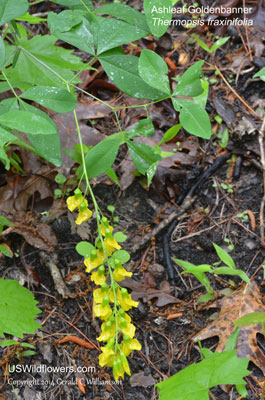
| | Site: Mill Creek Road, Murray County, GA Date: 2014-May-15 | Photographer: Gerald C Williamson | | The leaf stipules are another species diagnostic. Thermopsis villosa (Aaron's Rod) has larger, clasping stipules, while those of T. mollis and T. fraxinifolia (as shown here) are not clasping. | | Click on the photo for a larger image
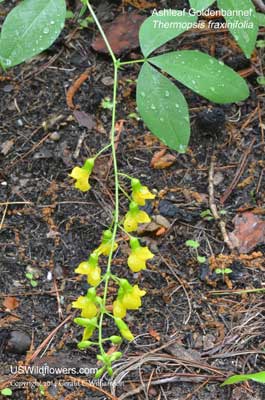
| | Site: Mill Creek Road, Murray County, GA Date: 2014-May-15 | Photographer: Gerald C Williamson | | The leaves on Thermopsis are alternate, petiolate, and palmately 3-foliate. The three leaflets are dark green, and up to about 4 inches long, 2 to 3 times longer than wide. | | Click on the photo for a larger image
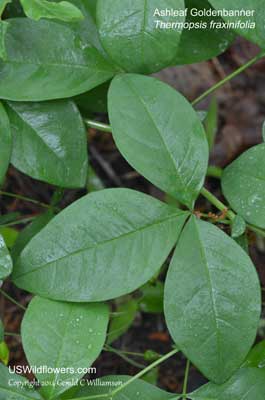
| | Site: Mill Creek Road, Murray County, GA Date: 2014-May-15 | Photographer: Gerald C Williamson
Nikon D7000 | | The developing fruit of Thermopsis fraxinifolia (Ashleaf Goldenbanner). | | Click on the photo for a larger image
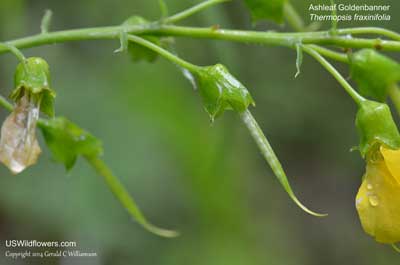
| | Site: Big Frog Trail, Polk County, TN Date: 2004-May-30 | Photographer: Gerald C Williamson | | Ashleaf Goldenbanner is pretty rare throughout its limited range, and is classified as "Threatened" in Tennessee, where this photo was taken on the north slopes of Big Frog Mountain. This species is generally found in moderate to high elevations, usually 2,000' to 6,000', although sometimes at lower elevations. This photo was taken probably around 2200'. The other photos on this page were taken at about 1800'. Thermopsis mollis generally grows at lower to moderate elevations, between 600' and 2500', so the photos on this page were taken in the overlap between the two species. | | Click on the photo for a larger image
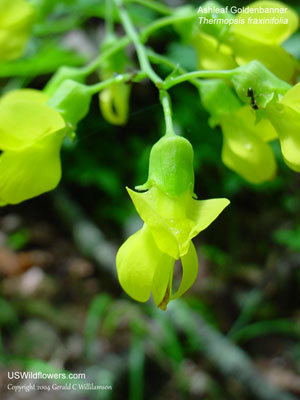
|
References used for identification and information:
|
|
| |
| #ad
|
|








